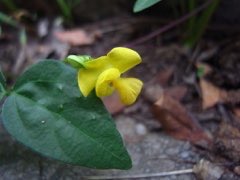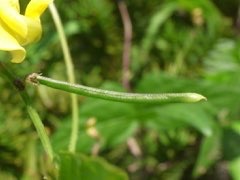 |
|
Dalgial Wikimedia Commons |
 |
| Dalgial Wikimedia Commons |
Translate this page:
Summary
Vigna angularis, commonly known as Adzuki Bean or Red Mung Bean, is an annual vine in East Asia and the Himalayas. It grows usually about 30-90 cm in height. The root system is a taproot that can reach a depth of 40-50 cm. The leaves are trifoliate, pinnate, and arranged alternately along the stem on a long petiole. The flowers are bright yellow papilionaceous arranged in a cluster of 6-10. The fruits are smooth, cylindrical, and thin-walled pods. Adzuki bean is commonly sweetened before eating. It is eaten sprouted or boiled. It is also used in many Chinese dishes and as a filling in Japanese sweets. Tender young pods are cooked as a vegetable. Roasted seeds are used as a substitute for coffee. Medicinally, the beans are used in the treatment of kidney diseases, constipation, abscesses, certain tumors, threatened miscarriage, retained placenta, and non-secretion of milk. Seed sprouts are used to treat threatened abortion caused by injury. A flour made from the beans is used in making shampoos and facial creams. V. angularis is also grown as a green manure and for soil erosion control.
Physical Characteristics

 Vigna angularis is a ANNUAL growing to 0.8 m (2ft 7in) by 0.2 m (0ft 8in) at a fast rate.
Vigna angularis is a ANNUAL growing to 0.8 m (2ft 7in) by 0.2 m (0ft 8in) at a fast rate.
See above for USDA hardiness. It is hardy to UK zone 10. The flowers are pollinated by Bees.
It can fix Nitrogen.
Suitable for: light (sandy), medium (loamy) and heavy (clay) soils and prefers well-drained soil. Suitable pH: mildly acid and neutral soils and can grow in very acid soils.
It can grow in semi-shade (light woodland) or no shade. It prefers dry or moist soil and can tolerate drought.
UK Hardiness Map
US Hardiness Map
Synonyms
Azukia angularis (Willd.) Ohwi. Dolichos angularis Willd. Phaseolus angularis (Willd.) W.Wight Phase
Plant Habitats
Edible Uses
Edible Parts: Seed Seedpod
Edible Uses: Coffee
Mature seed - cooked. The dried bean is boiled and used in a wide variety of dishes. The beans can also be popped in much the same way as popcorn[301 ]. The dried seeds can be ground into a meal and used in soups, cakes or confections[310 ]. The seeds are often sprouted and then eaten either raw or cooked[200 ]. The cylindrical pods can be 6 - 12cm long, containing 6 - 14 seeds[418 ]. Tender young pods are cooked as a vegetable[301 ]. The seedpods are up to 10cm long[200 ]. The roasted seed has been used as a coffee substitute[301 , 310 ].
References More on Edible Uses
Medicinal Uses
Plants For A Future can not take any responsibility for any adverse effects from the use of plants. Always seek advice from a professional before using a plant medicinally.
Antitumor Febrifuge Kidney Laxative
The beans are used to treat diseases like kidney trouble, constipation, abscesses, certain tumours, threatened miscarriage, retained placenta and non-secretion of milk[310 ]. The seed sprouts are used to treat threatened abortion caused by injury[310 ]. The leaves are said to lower fevers[310 ].
References More on Medicinal Uses
The Bookshop: Edible Plant Books
Our Latest books on Perennial Plants For Food Forests and Permaculture Gardens in paperback or digital formats.

Edible Tropical Plants
Food Forest Plants for Hotter Conditions: 250+ Plants For Tropical Food Forests & Permaculture Gardens.
More

Edible Temperate Plants
Plants for Your Food Forest: 500 Plants for Temperate Food Forests & Permaculture Gardens.
More

More Books
PFAF have eight books available in paperback and digital formats. Browse the shop for more information.
Shop Now
Other Uses
References More on Other Uses
Cultivation details
Adzuki bean is a plant of the subtropics, and is widely cultivated from the temperate zone to higher elevations in the tropics, where it is can be grown at elevations from 420 - 1,500 metres. It grows best in areas where annual daytime temperatures are within the range 15 - 30°c, but can tolerate 5 - 36°c[418 ]. The plant cannot tolerate frost. It prefers a mean annual rainfall in the range 900 - 1,300mm, but tolerates 530 - 1,800mm[418 ]. It is generally seen as a short-day plant, requiring a day length of 12 hours or less to initiate flowering and fruiting, though cultivars can vary in their response to day length[200 ]. Requires a sunny position[418 ]. Succeeds in a wide range of well-drained soils[418 ]. Prefers a pH in the range 5.5 - 6.5, tolerating 5 - 7.5[418 ]. Some cultivars are fairly drought tolerant[200 ]. The plant can commence cropping within 60 - 190 days from seed[418 ]. Average seed yields range from 1 - 2.5 tonnes per hectare. In Taiwan yields of 1,450 kilos are common, in Japan 1,900 kilos, in Kenya 500 - 600 kilos and in New Zealand 1,340 - 2,240 kilos[418 ]. There are many named varieties[301 ]. This species has a symbiotic relationship with certain soil bacteria, these bacteria form nodules on the roots and fix atmospheric nitrogen. Some of this nitrogen is utilized by the growing plant but some can also be used by other plants growing nearby[200 ]. When removing plant remains at the end of the growing season, it is best to only remove the aerial parts of the plant, leaving the roots in the ground to decay and release their nitrogen. Bloom Color: Bright Yellow. Spacing: 3-6 in. (7-15 cm).
References Carbon Farming Information and Carbon Sequestration Information
Temperature Converter
Type a value in the Celsius field to convert the value to Fahrenheit:
Fahrenheit:
The PFAF Bookshop
Plants For A Future have a number of books available in paperback and digital form. Book titles include Edible Plants, Edible Perennials, Edible Trees,Edible Shrubs, Woodland Gardening, and Temperate Food Forest Plants. Our new book is Food Forest Plants For Hotter Conditions (Tropical and Sub-Tropical).
Shop Now
Plant Propagation
Seed - pre-soak the seed for 12 hours in warm water and sow in situ. It requires soil temperatures above 16 ?c for germination[310 ].
Other Names
If available other names are mentioned here
Adzukibohne, Azuki, Chi dou, Chinese red bean, Fagiolo adzuki, Feijao adzuki, Frijol adzuki, Guruns, Haricot anguleux, Hong xiao dou, Pat, aduki bean, adzuki bean, adzuki-bean, adzukibohne, azuki, azuki-bean, chi xiao dou, chixiaodou, fagiolo adzuki, frijol adzuki, haricot adzuki, judía adzuki, pat, phaseoli angularis semen, red bean, rice bean, semen phaseoli, semen phaseoli calcarati, vignae semen.
Native Range
TEMPERATE ASIA: Japan (Honshu, Kyushu, Shikoku), Taiwan
Weed Potential
Right plant wrong place. We are currently updating this section.
Please note that a plant may be invasive in one area but may not in your area so it's worth checking.
Conservation Status
IUCN Red List of Threatened Plants Status : This taxon has not yet been assessed

Growth: S = slow M = medium F = fast. Soil: L = light (sandy) M = medium H = heavy (clay). pH: A = acid N = neutral B = basic (alkaline). Shade: F = full shade S = semi-shade N = no shade. Moisture: D = dry M = Moist We = wet Wa = water.
Now available:
Food Forest Plants for Mediterranean Conditions
350+ Perennial Plants For Mediterranean and Drier Food Forests and Permaculture Gardens.
[Paperback and eBook]
This is the third in Plants For A Future's series of plant guides for food forests tailored to
specific climate zones. Following volumes on temperate and tropical ecosystems, this book focuses
on species suited to Mediterranean conditions—regions with hot, dry summers and cool, wet winters,
often facing the added challenge of climate change.
Read More
Expert comment
Author
(Willd.) Ohwi & H.Ohashi
Botanical References
Links / References
For a list of references used on this page please go here
A special thanks to Ken Fern for some of the information used on this page.
Readers comment
| Add a comment |
|
If you have important information about this plant that may help other users please add a comment or link below. Only comments or links that are felt to be directly relevant to a plant will be included. If you think a comment/link or information contained on this page is inaccurate or misleading we would welcome your feedback at [email protected]. If you have questions about a plant please use the Forum on this website as we do not have the resources to answer questions ourselves.
* Please note: the comments by website users are not necessarily those held by PFAF and may give misleading or inaccurate information.
To leave a comment please Register or login here All comments need to be approved so will not appear immediately.
|
Subject : Vigna angularis
|
|
|
|